#CHEN TAKEOVER EVENT!
Text
Time for the sixth installment to the Chen Takeover! It's time for the Silly/OldSchool RuneScape Cover! Now, like I've said before, I've never played OldSchool RuneScape, so I don't know how close I got to its music style apart from what I've heard on accident, but I think I did really good here. I have a bestie that can confirm how close I actually got, but I think all the saxophones with the shenai and sax synth give it the same feel the game has from what I've heard. I like this either way!
@motsimages @mango-frog @caniscreamintoanabyss @lesserbeans @k4ndi-c0spl4y3r @kinokomynx @he-was-beautiful@fembutchboygirl @semisentient-entity@siegesquirrel42@soulless-paper-bag @space-frog-boy @insertusernamethatsnottaken @the-cinnamon-snail @the-kneesbees @that-bastard-with-all-the-bones@reblogging-corner @womensrightsstegosaurus @please-put-me-in-the-microwave @da-silliest-snek @scarletdestiny @chengoeshonk @oneweekwitch
#bluey's music#bluey's birthday posts#bluey's hyperfixations#bluey's fun posts!#bluey's silly covers#bluey's songs#bluey's audios#bluey's instrumentals#bluey's touhou resounds#bluey's resounds#bluey's takeover events#CHEN TAKEOVER EVENT!#touhou#touhou project#touhou pcb#touhou chen#chen touhou#I finally figured out how to properly fix the discordant notes in this version#it sounds so much better now#I imagine this playing while adventuring in a field with little orb looking creatures you have to defeat#peri-alice era#abluehappyface
24 notes
·
View notes
Note
How is Marshal Kingsley’s relationship with the media? Are there any interesting or funny rumors about them? What does Ortega hanging around do to their reputation?
And What about Marshal and Hallowed Ground? Are they after or interested in each other?
Kingsley is not a fan of cameras or being perceived, but understands that the media is a required tool of the job and is therefore willing and capable of handling them. They’re very stoic, so it can be difficult to draw the charm out of them, but they know when a situation calls for a light small, a small display of emotion—the human element, to give life to the superhero fantasy. Poise, compassion, respect: treat the media well, don’t manhandle them, and be precise with your words—don’t let them spin a story from something you said. The media enjoys speculating on Kingsley’s abilities, enjoys making up ideas about their past and home life, and reeeally likes to push the hero aspect of them. The stance, the height, the attitude: it draws in the views and sells the merch.
There was a rumour for a while that they were part of a military takeover of Los Diablos along with Chen and other ex-military boosts and mods, though that came out of untrusted sources despite sticking around for a while. There is a lot of tinfoil anti-telepath propaganda in chat rooms on the web from people who are 1000% sure telepaths are reading their thoughts at all time to better target them with consumerism. And a very fun rumour that they and Chen are secretly married and act so sternly and military to keep up appearances.
Ortega hanging around has lent his audience to the Rangers and vice versa, kicking up even more gossip and attraction to him joining the ranks. People think the two might be dating, lots of people love the opposing dynamic to the point that it’s been put into movies and shows, and some media outlets think Charge is trying to seduce his way in thus damaging the reputation of the Rangers as a government agency.
Marshal has not yet been ordered to make a move against Hollow Ground, but a few of their spots are being watched. Hollow Ground’s sources have kept them away from any event that the Marshal may have been attending, just in case. They are both very aware of each other, but there have been no steps taken. Not officially.
6 notes
·
View notes
Text
When Kai, Zane, Jay, and Cole came to the Chen house, things seemed to be chaotic. By chaotic, things started out peacefully then took an immediate wrong turn, and everyone was trying to stay calm.
J: Uh... Is this a bad time?
Z: I am not entirely sure.
Aidan crawled up to Zane.
Aidan: Fada!
Zane picked Aidan up.
Z: Do you know what happened here?
Aidan: Couch went boom.
C: Maybe we go on the lake trip later.
Kai sighed in relief.
Z: Uh, Pixal! The guys and I are here now! We’re gonna take the kids and their stuff back home!
The guys gather the three remaining babies and their stuff and went back home.
K: What do you think that was about?
J: I don’t think any guesses in the world could guess what happened.
(Polyponytail takeover event is now over.)
5 notes
·
View notes
Text
Character File: Sage Brooks
Note- This is the updated version of Sage’s initial “Fact File”
Warning- Brief mentions of parent death, death, abandonment, and bullying. Nothing descriptive or angsty, this isn’t a story just a fact file, but I’m adding warnings anyway.
Also uh…I know parts of her story might not be...totally believable or even sorta stretched? But trust me when I say this is much better than her original story.
Also also, it's very very long. So..be prepared. Wish there was a way to sum this all up.
------------------------------------------------------------------------------------------------------------------------------------
Full Name- Sage Celia Brooks
Birthday- August 15th, 2002/1999
Age:
Canon: 18 - 21
Future: 26 - 29
Hometown- Eyton, Northern Ninjago
(Blood) Family- Aster Brooks (father; deceased), Lily Brooks (mother; deceased)
(Found) Family- Asher Woodman (older brother figure), Marion Nettle (younger brother figure)
(Future) Family- Willow Woodman (Niece), Cedar Woodman (Niece), Katlyn Woodman (Sister in law)
Hair- Black, falls to the center of her back, usually pulled into a braid of some form.
Eyes- Silver
Height- 5”3’
---------------------------------------------------------------------------------------------------------------------------------------
Sage grew up in a small Northern village by the name of Eyton, a traditional, old fashioned place, where the main income was fish and river crustaceans/mussels.
Sage’s parents moved to Eyton a year before Sage was born, taking an old, partially abandoned house as their own and fixing it to their liking. Aster took a job on the fishing boats, and hunted in the nearby forests both to bring meat home and bring in extra cash. Lily opened a baking business, and sold flowers during festivals.
While there wasn’t any proof of the matter, people of Eyton whispered about how Aster looked suspiciously similar to a man who’d accompanied a gang that’d caused some trouble a few years prior, until a warrior had chased them off.
Again, without proof they couldn’t hold a trial or even attempt to kick him and his slowly growing family out, but that didn’t stop the villagers from turning up their noses and even encouraging their kids to stay away from Sage and her parents.
Despite her social isolation, Sage was a very sweet child, who always tried to be nice to her classmates despite feeling that they hated her. She wasn’t blind to the way adults acted whenever she walked through town with her father.
When she was seven years old, one of the town’s fishermen was found dead on shore, an arrow sticking out from his skull. Aster was the only notable archer in town, and it was noted that he’d had an argument with the man a few nights prior. Given his possible prior gang affiliations, he was placed under house arrest until a proper trial could be put together.
The trial would be put off when an illness, deadly to adults (when left untreated) but nonlethal for children under seventeen, swept through the village. Lily caught said illness, and despite Aster’s attempts to take care of her, refusal from the village to treat her and inevitably Aster himself led to both of their deaths.
After burying both her parents within the same week, Sage was kicked from the village after a mostly unanimous decision.
For two years Sage wandered about alone, until she came to a village with a stone wolf statue in the center.
On her third day there, she was cornered by a group of town kids, who taunted her and pushed her around until another street kid, a boy with white hair and blue eyes, stepped in and fought of the bullies.
He only spent a few seconds checking to make sure Sage was ok, before turning to walk off by himself, determined to remain alone.
Within that same week, a skeleton horde attacked the village. Sage was quick to find an elevated porch to hide under, hoping she could wait out the raid.
This was when she spotted the white haired boy running, assumedly from the skeletons. Thinking quickly, she grabbed him and dragged him under the porch before he could be spotted.
After what felt like hours of awkward silence between them, the boy introduced himself as Asher and the two ended up spending the night under the porch.
They decided to stick together afterwards, Asher stating that they’d be partners, looking out for each other to survive.
Sage would grow to care very much for Asher (platonically and soon in a familial way), and while Asher felt the same, he struggled to come to terms with caring for someone other than himself for a long time.
When Sage was eleven, Asher managed to…find a job. A thief named Ronin offered to hire them for help on a job. Despite Sage feeling the job betrayed her morals, she didn’t was Asher to do the job alone, and so, she agreed to join.
And this was the beginning of Sage’s long life of crime. As they got older, their names were spread around more and more, and soon a steady enough flow of money began to come in.
As time went on, certain events started to change Sage’s overall demeanor and personality. At the beginning of her teenage years, anxiety and general depression ran rampant. By sixteen, an apathy started to overtake her. She started losing touch with the caring, over all happy girl she’d once been.
During the SOG takeover, Sage became a target for UV’s wanted list after shooting some of the gang members. (Reason has yet to be determined). She caught the attention of Mr.E while running over the rooftops, and miraculously escaped with few injuries.
Sometime, early on in the takeover itself, Sage was traveling across the rooftops when she found a boy cornered by SOG members. She didn’t hesitate to shoot the gang members in the head with her bow, only realizing later that there may have been a more merciful way to deal with them.
After learning that the boy didn’t have a place to go, she brought him with her to the apartment she shared with Asher at the time. He would introduce himself as Marion.
Something about the rescue inspired her, and from there she would do her best to save other targets of the SOG for the remainder of the takeover.
This was the start of a change in Sage, one that would reconnect her with herself. She started caring more, smiling again, thinking of different ways out of situations than just...shooting first. She felt severe guilt, but she also felt a form of freedom. She realigned her morals.
Sage would do her best in the years that followed to provide Marion with a better life than her own, and would become a main supporter in his journey to master his element and become one of Ninjago’s protectors.
Three years later, Sage ended hiding a young man with a green streak of hair from a team of muggers. Deciding to take a risk, she invited the strange man to their home. She wouldn’t let him know that she recognized him as the Morro until a week or so later.
While Morro never joined in the thieving business, he did freelance with lifting and loading jobs to pull his weight. He’d also become Marion’s mentor later on.
------------------------------------------------------------------------------------------------------------------------------------------
In the future- Eventually, Sage would leave the crime life. The guilt of her actions and belief that her parents would be sorely disappointed in the way she’d led her life drove her to quit.
She would never turn herself in, instead running a branch tea shop with a close friend, volunteering and donating when and where she can as an attempt to give back.
She’d continue to be a supportive and loving figure in her brothers’ lives.
-------------------------------------------------------------------------------------------------------------------------------------
Season by Season:
- Season 1- Sage meets Asher
Sage and Asher were in a village that was attacked by the Skeleton Horde
She was in Jamanakai with Asher when Lloyd first attempted to raid the place for candy.
She was going to offer to help him snag some candy, but got scared off when the ninja arrived.
- Season 2- Sage and Asher continue their partnership, their loyalty and trust has grown quite a bit.
- Season 3- Sage and Asher begin their lives in crime.
One of the jobs Ronin hired them for was keeping an eye out while he grabbed Zane.
- Season 4-
They were in one of the villages attacked by Chen’s cultists.
- Season 5- Asher and Sage officially refer to each other as siblings.
They were in Styx when the ninja attempted to steal from Ronin. Sage saw them leaping across the roofs.
- Season 6- With the ninja’s rise in fame, stealing becomes both harder and easier. On one hand, they’re too busy to come after them. On the other, cops were alerting the Ninja to every crime. Sage and Asher end up laying low.
- Season 7- When Borg disappears, Sage and Asher are given the job of stealing his tech.
- Season 8- Sage and Asher are offered a job by Harumi, but they ultimately turn it down.
- Season 9 – Sage is wanted by the SOG, saves Marion, and begins fighting against the SOG.
- Season 10- Sage, Asher, and Marion hide in an underground bunker during the oni attack. This is when they meet Jerome Rune and Calvin Rune.
Season 11- Sage, Asher, and Marion were not in the city during Aspheera’s attack. Rather, they were trying to remove Marion’s vengestone cuffs. They spent the rest of the season try to help Marion with his abilities.
- Season 12- The minute Sage hears about the video game linked disappearances, she drags the boys away from the city and to a rural village. Girl isn’t taking any chances.
Later that year, Sage meets Morro
--------------------------------------------------------------------------------------
Facts:
- Her father taught her the archery basics; she chose to learn how to shoot and uses a bow as her primary weapon because of her father’s prowess with the weapon.
- She taught Marion and Asher’s daughters how to use a bow.
- Has callused fingers from archery.
- Can throw knives like a boss.
- She does know a few things about fighting, but it’s not her strong suit and she prefers long range and dodging to melee and hand to hand combat.
- Her favorite tea is Passion flower, and her favorite food is puffy pot stickers(or just pot stickers in general)
- She has a kill count of 27, and is very closed off when asked about it.
- She can pick locks relatively well, including handcuff locks and jail cell locks.
- Like Asher, she is notorious for breaking out of holding cells and police custody.
- Every year since she was 14, she visits Eyton to update her parents on her life and apologize for the life she is living.
- Learned to drive a car and ride a motorcycle at 15. A fellow thief for hire taught Asher and Sage.
- Built/repurposed her motorcycle, Asher’s motorcycle, and their pickup by herself.
- Her motorcycle is her baby and if you break it she will break you.
- Impulse drives her motorcycle when incredibly stressed.
- Taught herself mechanics and medical stuff
- Got all of her education from libraries, everything she knows about math, history, etc. is self taught
- She was 17 when she got her first tattoos.
- In total she has four tattoos. A raven carrying a hyacinth on her back, vines around her right arm, an ace flag yin yang on her left, and Edelweiss around a knife in a currently undetermined location.
- Each tattoo has some varying form of significance.
- She picked up roof running to help with jobs, it became a hobby later on
- Tried to teach herself guitar, but they moved around too much for her to focus on it.
- Family is everything to her.
- A sign that you have her full trust you is that she becomes willing to be more...physical around you. Nudging your arm, playful punches and shoves, hugs, hair ruffling. She also won’t freeze or tense up if you grab her suddenly.
-Basically she becomes notably less awkward and anxious, and wary around you.
- She is fiercely loyal, and will stay by your side even if it means she might die.
- Very tired and frequently has nightmares. Anxiety and guilt also prevents sleep.
- Has to have a knife on her person at all times in order to feel safe; even in her own home and while she sleeps.
- Crystal necklace is from a friend, a reminder that she isn’t alone and that she has people there for her.
- Various scars, each with their own story.
- Most people don’t assume Sage is a criminal when they first meet her.
4 notes
·
View notes
Text
A Year of FIDM: 2018

2018 was one for the books at FIDM! From takeovers to events to collaborations, let’s recap on what happened at FIDM this past year.
FIDM Instagram Story Takeovers

January 10th - FIDM Graduate and Laundre founder Ariana Roviello

January 17th - FIDM Beauty Student Paulina Char

January 24th - Paris Couture Fashion Week takeover by FIDM student Wilson Chen
February 22nd - FIDM Alumna, Cait Courneya, shows a day in the life of a freelance illustrator and textile/home goods designer

March 7th - Addi & Ally Hurst share their FIDM Acceptance experience
March 8th - FIDM Business Management Grad & Poshmark Marketer, Amanda Weiss, shows a day in her work life
April 4th - FIDM Business Management Grad, Ida Sofia, gives us a peek into her candle business Evil Queen
April 16th - FIDM student Jordyn Jade gave us a creative look at Coachella
April 30th - FIDM Grad, Anika, shared her story of starting a fashion label, Wear Anika, in the Philippines
May 1st - FIDM Jewelry Design Grad, Zivanora, shared her Jewelry Company process in Nigeria

May 4th - FIDM student, Charlotte Nygard showed us around FIDM San Francisco
May 10th - FIDM Grad, Thai Nguyen, gave us a look into his inspiring career at Thai Nguyen Atelier
May 15th - Mind Khunteera Pachimsawat shows what FIDM Interior Design students get up to
June 4th - FIDM Alumna & Bachelorette star, Desiree Siegfried, shared her insights and advice

July 12th - FIDM Grad, Ana Christine, took us around her internship at Anthropologie HQ
July 24th - Nicky Fletcher shared how she was accepted into FIDM as a Junior in high school

August 14th - FIDM Beauty Industry Management student, Jasmine Haffar, took us through her job at ColourPop Cosmetics
September 5th - Mason Segal shows a day in the life of a FIDM Apparel Technical Design student
September 8th - FIDM Grad, Diandra Barnwell, shows her life during NYFW

September 12th - FIDM Alumna, Teresita Marie, tookover to show her life as a Costume Designer & Wardrobe Stylist
October 19th - FIDM Grad, Janelle Biehl, took us around her job at Smashbox Cosmetics
December 4th - Savannah Spinola showed life at FIDM San Francisco
FIDM Students
January 10th - FIDM IMPD students visit Hong Kong to learn more about global sourcing
January 30th - FIDM Entertainment Set Design & Decoration students visit Warner Bros. Entertainment
February 13th - FIDM Film & TV Costume Design students visit costume designers on the set of Young Sheldon
February 14th - FIDM Alumna & Pretty Little Liars Costume Designer, Mandi Line, cam and mentored FIDM Visual Communication students
March 6th - Artist & Estee Lauder Creative Director, Donald Robertson, came to talk with students
March 15th - FIDM Menswear students visit manufacturing companies in the Dominican Republic
March 22nd - FIDM Entertainment Set Design & Decoration Students visit London

March 24th - FIDM students embark on the FIDM European Study Tour
March 27th - FIDM Beauty students take on the San Francisco Beauty Tour
April 30th - FIDM Footwear Grad, Chris Munar, came to visit and chat with students
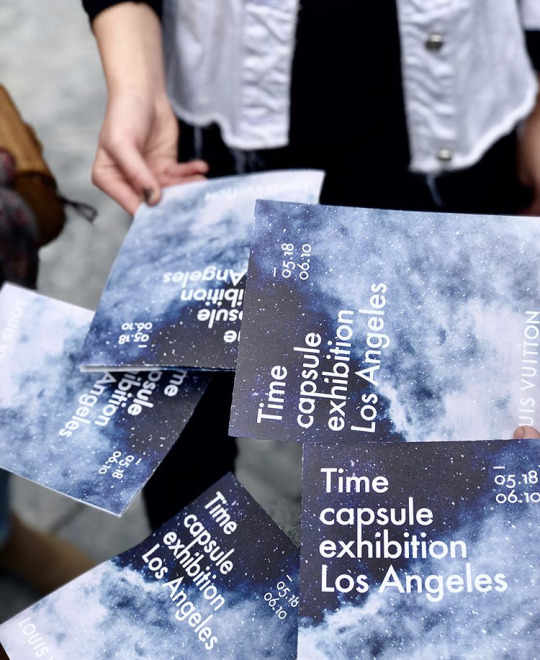
May 18th - FIDM students got to visit FIDM Grad, Katie Bozzi, at the Louis Vuitton Time Capsule Exhibition
May 25th - FIDM Beauty Industry Management students visit industry leaders in NYC
June 12th - FIDM Masters in Business Admin students design their own board games
July 20th - FIDM Grads participate in the Her Universe Fashion Show at Comic Con
September 17th - Fashion, Interior, and Textile Design students have come together to create magic for the FIDM DEBUT 2019 Charing Styles segment
September 19th - FIDM Business of Denim students visit Tokyo

September 25th - FIDM IMPD students visit Europe for trend research to prepare for their Herbalife collab

October 2nd - Fall Orientation

October 31st - Halloween Party
November 30th - Accomplished Costume Designer, Mary who was the Costume Designer for Crazy Rich Asians, spoke to Film & TV Costume Design Students
December 5th - FIDM Visual Communications students visit New York City

December 14th - FIDM Jewelry Design students presented their final collections
FIDM Events
January 16th - FIDM Fashion Club Day

February 3rd - FIDM Museum’s 26th Annual Art of Motion Picture Costume Design Exhibition

April 6th - FIDM DEBUT Runway Show

May 16th - FIDM Grad Carnival

June 5th - FIDM Museum ‘Capturing the Catwalk’ Exhibit which centered around world famous runway photographer, Michel Arnaud
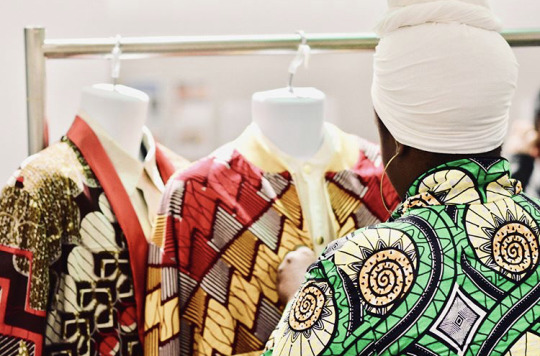
June 15th - FIDM Menswear students created collections centered around wearable technology and featured them in a special exhibition

June 18th - FIDM Graduation

June 21st - 3 Days of Fashion with Candice Cuoco & Chriselle Lim

July 9th - The FIDM Signature Summer Program
August 1st - Top FIDM Alumni came back to FIDM for Career Connections

August 11th - Open House with panelists: Jordan Byers, Amanda Weiss, Drew Scott, and Bri Emery
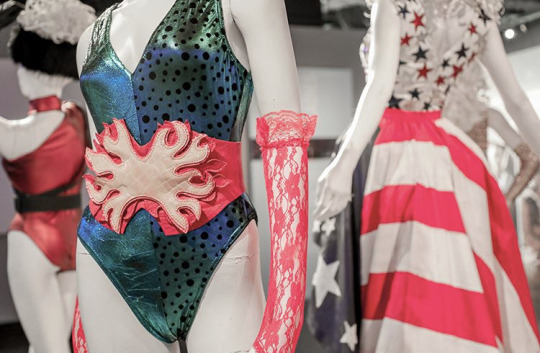
August 18th - FIDM Museum’s 12th outstanding art of television costume design exhibition
September 26th - Emmy winning Game of Thrones Costume Designer, Michele Clapton, visited the FIDM LA campus to discuss her work
October 22nd - FIDM MODE Launch Party

November 1st - The FIDM Library had an innovative materials display
November 1st - Sabri Sansoy, who teamed up with Marchesa and IBM Watson to construct an interactive dress for the 2016 MET Gala, came to talk to students

November 19th - The FIDM Museum had an exhibition featuring work from FIDM B.A. in Design Graduates
FIDM Collaborations

March 19th - FIDM IMPD students collaborate with Converse

March 20th - FIDM students collaborated with American Red Cross to create gowns

April 16th - FIDM collaborated with Disney to have a winning students art work featured at the world premiere of Avengers: Infinity War as well as winning tickets to attend the premiere
May 19th - FIDM students collaborated with Levi’s to create custom 501 jeans
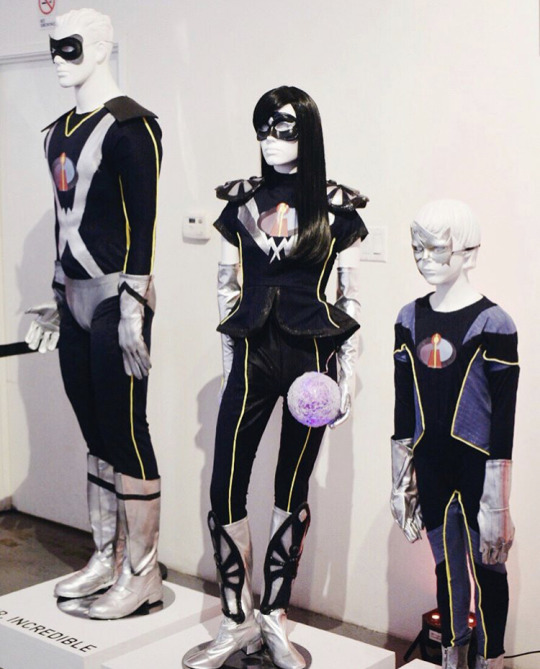
June 2nd - In collaboration with Disney, FIDM Film & TV Costume Design students created supersuits based off of The Incredibles
June 19th - FIDM Graphic Design & Beauty Industry Management students collaborated to create conceptual beauty products for the year 2050 with Cosmoprof
September 3rd - FIDM Visual Communications students created window dsplays for Dita Eyewear

September 26th - Kian Lawley was on campus

October 7th - Patrick Starrr was on campus
October 13th - James Charles, Drew Scott and Nikita Dragun were on campus

November 7th - FIDM students collaborated with RedBull to redesign their ‘RedBull Wings Team Los Angeles’ apparel collection

November 10th - Kandee Johnson was on campus
December 13th - FIDM students collaborated with GUESS to create sustainable designs ‘

December 24th - FIDM students collaborated with UNIQLO to create sustainable denim designs
youtube
To learn more about FIDM, the FIDM Life, and FIDM Students and Alumni, make sure to check out the FIDM website and follow all of the social media platforms:
Instagram:@fidm
Facebook: @FIDMCollege
Twitter: @FIDM
1 note
·
View note
Text
THE OUTLAWS/CRIMINAL CITY

To be honest, I didn’t have high expectations for this movie before I watched it. However, I came to realize how much I was enjoying the entire thing as I followed along. The thing about action movies, is that there is always something to look forward to, as the characters are deeply involved in whatever’s going on.
However, there are some drawbacks to action films, as there are times when the plot is jam-packed with fighting, and no development of a story. I did have such a worry for the The Outlaws after I read the plot summary, but luckily this movie did not sink to such a level, and so I was able to watch until the end.

In the opening scenes, we meet Detective Ma Suk Do, and as one scene transitions to the next, we see where Ma Suk Do is responsible for keeping the peace in the area where his team is located. The plot later points at an ongoing gang feud, and it seems as if the only person who can control these outlaws, is none other than Detective Ma Suk Do.
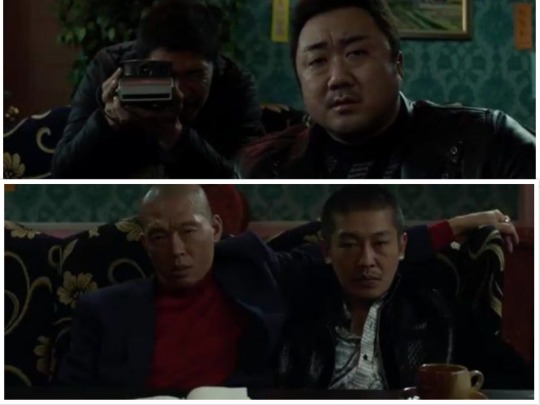
While Ma Suk Do’s methods are a little unconventional, he really is The Outlaws’ very own peacemaker. Capturing two rivals in one photo, is one method which this detective uses as a way to reinforce his control of the gangs. Even though there are moments in the movie where Ma Suk Do isn’t painted as a good cop, there’s no denying that he has the respect of these feared gang leaders.

Even though the plot is a bit fast-paced, the storyline doesn’t rush into the action at once. The plot does paint Ma Suk Do has the cop to fear, however this doesn’t mean that the rivalry between the gangs quickly comes to an end. While every other character is busy with their daily lives, a new player shows up on the scene, and his presence disrupts the hierarchy of the town.
Jang Chen has his reasons for coming to Seoul, and that’s simply to collect a debt. However, when it’s revealed that the borrower has ties to one of the gangs, things begin to go downhill from there. With the death of a popular gang leader, Jang Chen decides Seoul is the place to be, and so he begins his takeover.
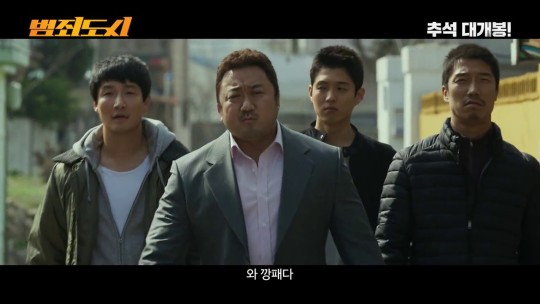
The workload of Ma Suk Do and his team gets a bit larger, with a few dead bodies here and there, multiple destruction of property and disruption of business reports; the only thing left for Ma Suk Do to do, is to restore order in his area. The race begins as this team makes it their mission to put an end to Jang Chen’s reign of terror.
From this point, I must warn you of a few scenes which may not sit well with you. On the other hand, I thought these scenes were really important to the plot, as they depicted how dangerous Jang Chen is. In addition, there is now a clear difference between the issues which Ma Suk Do had to deal with, prior to Jang Chen’s arrival.
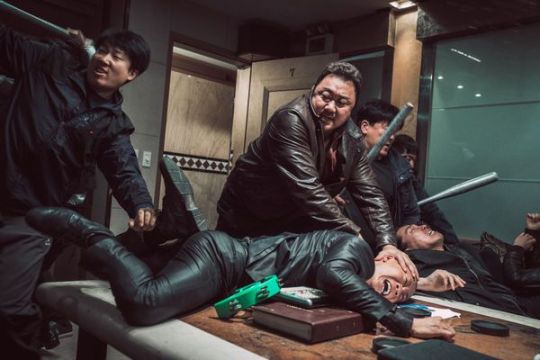
Jang Chen shows no fear and so he is able to successfully take his place as a gang leader, as well as a force to be reckoned with. Such development results in Ma Suk Do and his team cracking down on Jang Chen’s men, as the detective tries his utmost best to restore order.
I must comment on the action scenes in The Outlaws, and while such scenes can be considered as mature, I think they added a certain flavour to the plot. Therefore, the scenes complimented the storyline, as a movie of this nature, does indeed need action scenes such as these.

Ma Suk Do and his team do manage to clamp down on Jang Chen and his men. The one scene which I anticipated as I followed the plot, did not at all disappoint when it finally graced my screen. Ma Suk Do and Jang Chen had their final showdown, and while there were moments when Jang Chen seemed to have the upper hand, Ma Suk Do was able to overpower the crazy money lender-turned gangster in the end.
You would think that with an event such as this one, there would be at least some evidence of change, however things seemed to return to the way they were at the beginning of the film. However it’s safe to say that the residents and business owners, are now able to enjoy some amount of peace with Ma Suk Do present.
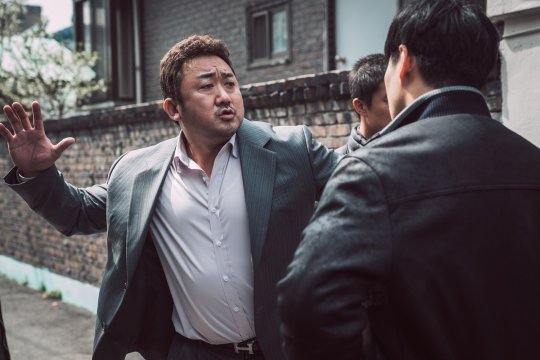
Ma Dong Seok plays the character of Ma Suk Do, a detective who’s sole responsibility is to keep the peace. However deep down it seems as if Ma Suk Do is the biggest outlaw in this movie, based on a few of his actions. Ma Dong Seok is a talented actor, with over at least thirty-five movie roles to his name. You can find him in the movies Train to Busan, and Derailed.
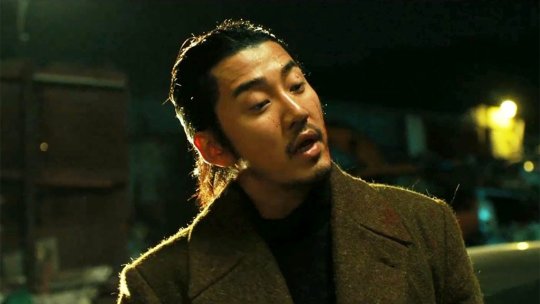
Yoon Kye Sang plays the character of Jang Chen, a dangerous man who seems to act before he thinks. Yoon Kye Sang is a former member of the popular 90′s group g.o.d., however he showcased his talent and skill in this movie, and so he must be commended. You can find Yoon Kye Sang in the dramas Last and The Good Wife.
The Outlaws was directed and co-written by Kang Yoon Sung who also worked on Last Concert. Lee Seok Geun also worked on the script, and he’s known for his work on Your Wedding and The Bros.
At the 2018 (54th) Baeksang Arts Awards, Kang Yoon Sung received an award for Best New Director. Jin Seon Kyu received an award for Best Supporting Actor at the 2017 (38th) Blue Dragon Film Awards.
It’s interesting to note that The Outlaws is based on the 2007 Heuksapa Incident in South Korea, where detectives arrested 32 persons who belonged to a criminal ring. These individuals are said to be ethnic Koreans who originated from Yanbian, China.
Plot: 5/5
Acting: 5/5
Cinematography: 5/5
Total: 15/15
(Credits to the owners of the pictures, I took them from asianwiki, youtube, cinemaclock, tadamonkugaiitakute, eyeforfilm, asianmoviepulse, soompi, and thegrandcinema)
(You can find The Outlaws on kissasian, and viki)
8 notes
·
View notes
Text
Xi Jingping Ready for Hong Kong Crackdown
LOS ANGELES (OnlineColumnist.com), May 28, 2020.--Flexing his muscle in Hong Kong, 67-year-old Xi Jinping showed his Communist Party boss side, imposing a new anti-sedition law on the once British Crown Colony. Last year’s protests pushed Xi to the breaking point, with violent protests over Hong Kong’s 62-year-old administrator Carrie Lam installing an extradition law to Mainland China. Lam’s attempt to impose a extradition law sparked violent protests led by 23-year-old pro-Democracy protester Joashua Wong. While there are other pro-Democracy activists, Wong’s still in the picture for now, before he disappears, winds up in a Chinese thought reform camp, never to be heard from again. When Hong Kong returned to Mainland China July 1, 1997 after a 99-year lease to the British, former Chinese Premier Jiang Zemin promised “Once Country, Two Systems,” underscoring the importance of Hong Kong’s independence.
Xi’s imposition of an anti-sedition law allows Beijing to crack down in Hong Kong, rooting out pro-Democracy protesters much like they did when the rolled tanks over students April 15 to June 4, 1989 in Tiananmen Square, killing hundreds, if not thousands, of protesters. Xi announced today a 6.6% increase to the national defense budget, telling the Peoples Liberation Army [PLA] to prepare for armed conflict in Hong Kong and possibly Taiwan. Speaking at the National Peoples Congress [NPC] in Beijing, Xi told military officials to “explore ways of training and preparing for war” during the coronavirus AKA SARS CoV-2 or Covid-19 global pandemic. “It is necessary to explore ways of training and preparing for war because epidemic control efforts have been normalizes,” Xi told China’s state-run Xinhua News Agency, reported in the South China Morning Post.
Putting China on a war footing, Xi puts Hong Kong on notice that last year’s violent pro-Democracy demonstration led by Wong won’t be tolerated in 2020. Xi told the PLA it was “necessary to step up preparations for armed combat” to that the military can carry out new military adventures. Xi wants China’s military to “think about worst-case scenarios, scale up training and battle preparedness, promptly and effectively deal with all sorts of complex situations and resolutely safeguard national sovereignty, security and development interests,” Xi was quoted in Xinua. China’s SCMP defense ministry spokesman Wu Quan confirmed that China faces new post-Covid-19 security threats, including deteriorating Sino-U.S. relations. Under the gun with its role in the coronavirus global pandemic, China then starts beating the war drums with Taiwan, a thorn in China’s side.
China doesn’t recognize the independence of Taiwan, even though Gen. Chaing Kai Shek led pro-Democracy Chinese to the Island of Formosa during the genocidal Maoist revolution where some 20 to 50 million Chinese lost their lives from war or starvation. Xi’s molded by the brutality of the Maoist Revolution, thinking nothing of repeating Tiananmen Square or any other act of violence needed to crack down on Hong Kong. Dealing with Taiwan is another story, where the March 3, 1955 Mutual Defense Pact, had the U.S. defending Taiwan in the event of Mainland Communist invasion. When the Mutual Defense Pact was superseded by Taiwan Relations Act Jan. 1, 1979, China demanded the U.S. adopt a One China Policy, recognizing only Beijing. While the U.S. signed on, Washington continues to provide, at least under the radar, for the defense of Taiwan.
Xi has signaled that he plans to crack down at student demonstrations in Hong Kong. “The situation against separatism is getting grimmer,” Wu said today. “We have to make economic calculations but about that we have to make security calculations when we consider military spending,” anticipating more violent protests in response to Beijing’s new anti-sedition law. Once China announced a new anti-sedition law in Hong Kong, demonstrations broke out over the weekend on Hong Kong streets. China’s garrison leader in Hong Kong, Chen Daoxiang said he’s prepared to “act with firm resolve,” signaling China’s ready to set down street protests. “We are a very free society, so for the time being, people have the freedom to say what they want to say,” Hong Kong administrator Carrie Lam said. “Rights and freedoms are not absolute,’ putting protesters on notice there would be consequences.
Hong Kong residents are about to get a rude awakening that the days of old Hong Kong are long since gone. Whatever protests happened last year, Xi signaled he won’t tolerate them this year. Ben Bland, a fellow at Australia’s Lowy Institute, said Beijing’s new anti-sedition law is “going to basically take over Hong Kong,” something that’s already happened. Lam’s kidding herself that “we are a very free society,” when Beijing hangs over everything aspect of Hong Kong’s life. Taking over Hong Kong would trigger more U.S. sanctions on Hong Kong and China. Secretary of State Mike Pompeo said that a Beijing takeover of Hong Kong would “likely be unable to certify that Hong Kong maintains a high degree of autonomy, and if that happens, there will be sanctions that will be impose on Hong Kong and China.” Hong Kong’s getting that sinking feeling now that China’s cracking down.
About the Author
John M. Curtis writes politically neutral commentary analyzing spin in national and global news. He’s editor of OnlineColumnist.com and author of Dodging The Bullet and Operation Charisma.
0 notes
Text
It was my first 100% free flight, as I used my GetGo Cebu Pacific through my points that accumulated in my account. I took a late night Saturday flight to Taipei during my second visit to Taiwan. Therefore, it was obvious that I will arrived in the city at early morning the next day. Like what I did during my first visit, just eight months earlier, I rented a pocket WI-FI with the same provider I had before and picked it up at the same convenience store at the basement of the airport which opens 24 hours (as other provider are closed after 8 PM). After that, I went straight to the bus terminal, bought a ticket and waited for the next bus that brought me to Taipei. I checked-in to the same hotel that I had before since it is comfortable place to rest and near in Taipei Main Station.

Since it was Sunday, I had personal commitment in the morning, then I used the rest of Sunday exploring nearby places from my accommodation in Taipei, a walk-able tourist spot that I can visit in the afternoon. I started my walk from a well know station in the country, none other than Taipei Main Station.
Taipei Main Station
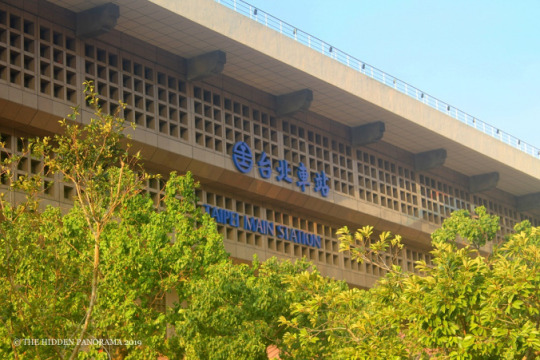
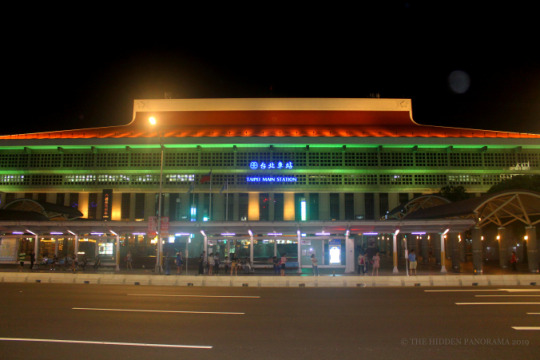
I came from in Xinzhuang District, New Taipei City for my morning commitment, I arrived in Taipei Main Station Bus Stop near Shin Kong Mitsukoshi Taipei Station Store and cross the road to reach the South Entrance / Exit of Taipei Main Station. I explored the station as I need to exchange the 3 Days Taiwan High-Speed Rail Unlimited Pass that I bought few days earlier before my scheduled flight to Taiwan. I bought the pass as I planned to explore places outside Taipei, to explore other parts of Taiwan. And while walking inside the station, I saw lots of people gathered at the center of the station, an open space which at first I thought that there were events happening but it was none.

This slideshow requires JavaScript.

That moment, I realized, most people came there in the open hall were mostly my countrymen. I remembered, it was Sunday – the common rest day of my fellow Filipinos that works in Taiwan. And then, I remembered the similar situation that I experienced when I worked in Singapore. Sunday is the rest day for most Filipinos that works as domestic helper and commonly meet up in Lucky Plaza in Orchard Road in Singapore. I learned it was the place where my countrymen usually meet up in Taiwan – Taipei Main Station it is. Observing them just like they were there, sitting together with acquaintances and friends, it was a social place that I thought maybe made them feel at ease as they with familiar faces back home.
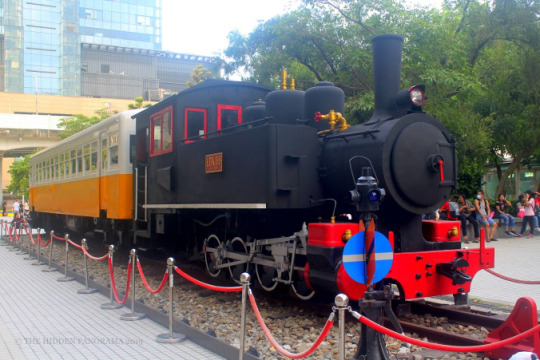
This slideshow requires JavaScript.
Taiwan Railway LDK58 Steam Train, Displayed at Taipei Main Station East 2 Exit
I went outside the station from East Exit and there I still saw Filipinos, just sitting around, spending their time to chill. Next, I saw a Taiwan Railway LDK58 Steam Train, displayed near East 2 Entrance / Exit of the station. And people came near the steam train to do a selfie photos with it. After taking couple photos of the steam train, I walked around from East part to South part of the station. At that time, I was still thinking where to go and then, I thought the first place to see where I can play with my DSLR camera, that was the North Gate.

Shin Kong Life Tower and Guanquian Road
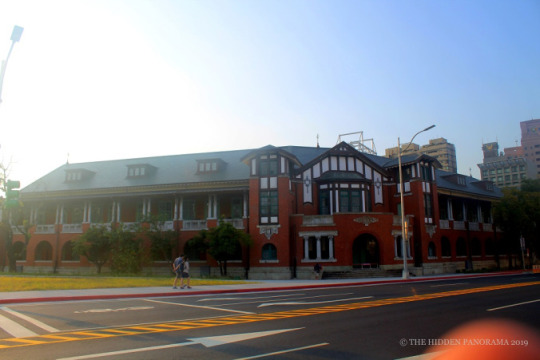
National Taiwan Museum of Railways
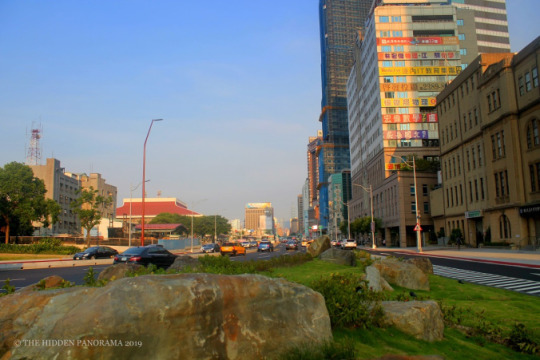
Zhongxiao West Road from Beimen Memorial Park

Bo’ai Road (left) and Yanping South Road (right) from Beimen Memorial Park

Beimen Post Office
North Gate (Traditional 19th Century Gatehouse)
North Gate is just few minutes walk from Taipei Station. During my first visit in the city, I had seen North Gate from a distance while taking bus and just passing the gate. In my second visit in the country, I freely enjoyed taking photos of North Gate that stands within Beimen Memorial Park.
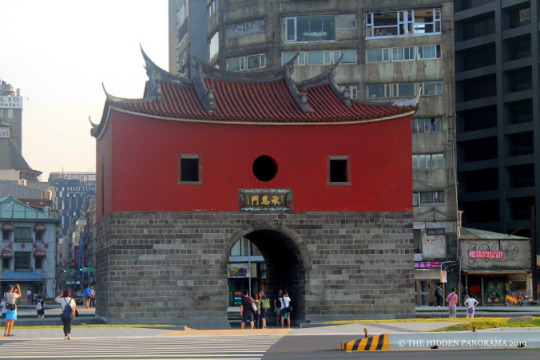
This slideshow requires JavaScript.



This slideshow requires JavaScript.
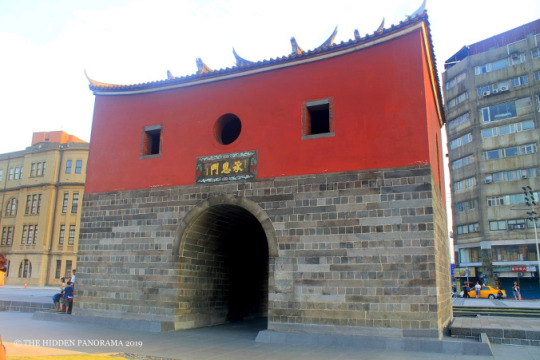
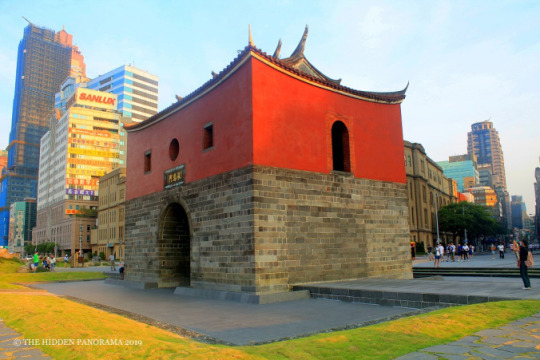
North Gate (Cheng’en men)
I did not realize that I will learn something about the Taipei City Wall while walking in Beimen Memorial Park. There were displays at the ground explaining the Cultural Significance of Old Taipei City’s “Axial Lines”, History of Taipei City Wall, how the city wall were built, its materials and structural features, how the stones quarried used to build the city wall and it also features the planting and paving design of the park itself which still conveys cultural significance related to North Gate. I honestly enjoyed my walk in the park.
Beimen Memorial Park (North Gate Square / North Gate Plaza)
The Cultural Significance of Old Taipei City’s “Axial Lines”

The Cultural Significance of Old Taipei City’s “Axial Lines”
Qing Dynasty Taipei City’s “Axial Lines” reveal two main strands of cultural significance. Taipei City’s “ceremonial axis” was constructed to run north-south from in front of the Taipei Yamen (government) to Wen and Wu Temples, along Chongqing South Road (then called Fuqian Street in the north and Wenwu Street in the south). This central axis and all north-south streets where directly aligned toward the North Star, forming a chessboard grid with east-west streets,Taipei’s fortified city was Taiwan’s only Qing Dynasty city to be laid out rectangularly. This spatial pattern manifest the city’s “ceremonial system” according to the “royal city” layout prescribed in the Book of Rites.
The History of Taipei City Wall

The History of Taipei City Wall
Plans to build Taipei City Wall were instituted by Chen Hsing-chu, the Magistrate of Taipei Prefecture, in 1879. Rough 5000 meters long, 5.76 meters high, 3.84 meters thick, and battlemented, it was topped by a horse path and surrounded by a moat.
Five gates served passage through the wall; Chen’enmen (the North Gate), Jingfumen (the East Gate), Baochengmen (the West Gate), Lizhenmen (the Main South Gate) and Chongximen (the Little South Gate). The North and West Gates were fortified on the exterior with enceintes. Built of stone, it was Taiwan’s only rectangular city wall, surpassing all others in height and magnificence. Construction of the wall and gate towers was completed in 1884.
How Stone Was Quarried for Taipei City Wall


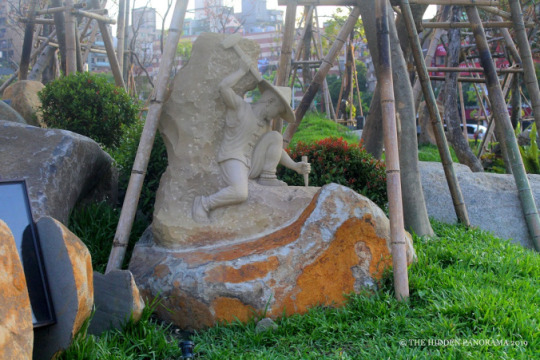
How Stone Was Quarried for Taipei City Wall
The stone materials for the wall and gates were obtained locally. The foundation slabs came from Beishihu in Dazhi, cut from the hill stones using small chisels. To extract each 12-foot-long slab, the workmen first chiseled out 7-8 equidistant square holes in the stone surface. They then placed 5-to-6 flat chisels 3 inches into the holes, obliquely inserted half-inch-thick iron plates on two sides of the chisels, and struck the chisels with 15-pound hammers to split off long stone bars. Finally, they cut the stone bars into small slabs, measuring one foot wide by four to five feel long, for ease of transportation.
Planting and Paving Design Concepts

Planting and Paving Design Concepts
The North Gate has the greatest historic significance among Taipei’s five gates. It was the most used tea merchants and foreign traders who congregated in Dadaocheng outside the wall. Governor Liu Ming-chuan built the train station nearby and the tax office machinery bureau and many foreign firms were located in the gate’s vicinity. The Qing government ceremonial arch for the reception of officials was set outside it.
The landscape design of the North Gate Square not only beautified the square but also gave expression to Taipei’s history and cultural essence. The paving and planting tell the story of each landscape element.
Jasmin Flowers
The tea trading firms in Dadaocheng enjoyed booming prosperity at that time. The jasmine used for scenting tea became a signature plant of the Dadaocheng tea industry.
Roadside Trees under Japanese Rule
The Japanese authorities removed the city wall to make way for the building the park like three-lane road – a symbol of modern urban planning. The carefully selected roadside tress, such as Bischofia javanica (bishopwood) and Cinnamomum camphora, hold special significance in the development of Taipei’s avenues.
The Building Materials and Structural Features of Taipei City Wall
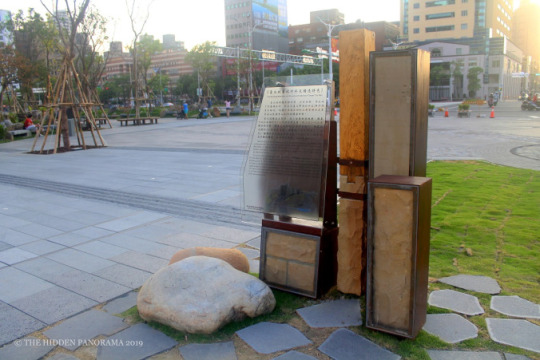
The Building Materials and Structural Features of Taipei City Wall
Two kinds of stone were used to build the Taipei City Wall. The underground foundations were built with sandstone take from the Beishihu in Dazhi (then called Qili’an stone), while harder grey-black andesite (Guanyinshan stone) was used for the wall’s protective facing.
To solve the challenge of the ground’s soft upper stratum, Chinese fir foundation piles were driven down to the hard soil sever meters below ground. Then, beams 3-5 meters long were placed horizontally to form a platform on which ten layers of sandstone labs were laid in a right-angled criss-cross pattern. The wall was about 3.6 meters thick. To form a strong protective shield, the wall was faced with andesite laid in a Flemish double-stretcher bond. Its interior was filled with pebbles and rammed earth.
This slideshow requires JavaScript.
About Taipei Prefecture
There is information displayed at the ground of Beiman Memorial Park regarding the Taipei Prefecture which was formed when Japanese takeover Taiwan where it has three business center : Taipei inner region , Monga (Southwest) and Dadaocheng (Northwest) outside of the city wall. Information also describes details of the prefecture, by mentioning what can be seen in every part of it. It mentioned what to be seen coming from South Gate, West Gate and North Gate regarding its old streets, temples and buildings.

Taipei Prefecture

South Gate Details
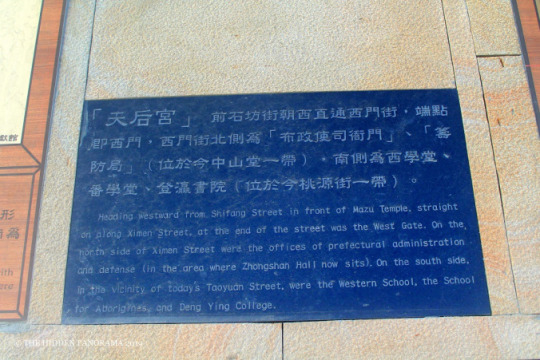


West Gate Details

North Gate Details
It was a relaxing walk in Beiman Memorial Park or The North Gate Square or The North Gate Plaza. It was also worth knowing that North Gate and the park itself was just recently renovated and improve as part of cultural preservation of Taipei. But I truly admired what Taiwan government did when they removed the elevated highway just to make emphasis of the historic North Gate as one of the symbol cultural heritage of the city.
Taipei Walks : Taipei Main Station, North Gate and Beimen Memorial Park It was my first 100% free flight, as I used my GetGo Cebu Pacific through my points that accumulated in my account. 1,681 more words
0 notes
Text
Time for the 8th Chen cover! I have once again taken a tiny break from posting, but I'm back! Today I bring you the Circus Cover for Chen! I LOVE this! It's so upbeat and dramatic, just like a circus should be!
@motsimages @mango-frog @caniscreamintoanabyss @lesserbeans @k4ndi-c0spl4y3r @kinokomynx @he-was-beautiful@fembutchboygirl @semisentient-entity @siegesquirrel42 @soulless-paper-bag @space-frog-boy @insertusernamethatsnottaken @the-cinnamon-snail @the-kneesbees @that-bastard-with-all-the-bones @reblogging-corner @womensrightsstegosaurus @please-put-me-in-the-microwave @da-silliest-snek @scarletdestiny @chengoeshonk @oneweekwitch
#bluey's music#bluey's birthday posts#bluey's circus covers#bluey's hyperfixations#bluey's fun posts!#bluey's songs#bluey's audios#bluey's instrumentals#bluey's touhou resounds#bluey's resounds#bluey's takeover events#CHEN TAKEOVER EVENT!#touhou project#touhou#touhou pcb#touhou chen#chen touhou#I LOVE THIS ONE SOOOOOO MUCH#IT'S EXACTLY WHAT A CIRCUS SHOULD SOUND LIKE#chen is having so much fun at the circus and you cannot change my mind#peri-alice era#abluehappyface
20 notes
·
View notes
Link
While economists enshrine Hong Kong as the ideal free market, the social consequences of its neoliberal policies have been disastrous.
MACABE KELIHER
For two decades, demonstrations—both peaceful and violent—have become ubiquitous in Hong Kong. The casual observer might readily point to 2014 and 2019 as key episodes of unrest, years that captured the world’s attention. The former demonstration channeled the spirit of Occupy Wall Street and took over three downtown and financial districts for seventy-nine days; it came to be known as the Umbrella Movement, referring to the now universal protest tool deployed to fend against the onslaught of police pepper spray. The latest protests erupted last spring and continued in force well into this year. At its peak they drew as much as a quarter of the Hong Kong population into the streets in a single day. Police violence and a strong-arm government backed by Beijing fired over 16,000 rounds of tear gas into crowds and arrested over 9,000 people. Riot police put out eyes, broke bones, smashed faces, and shot demonstrators, some as young as fourteen.
But such events are not uncommon in Hong Kong. Tens of thousands of marches, demonstrations, and protests take place every year. According to Hong Kong police statistics, there were 5,656 such protests in 2010 and well over 6,000 annually through 2015. That number jumped to 13,158 in 2016 and stayed well above 10,000 through last year. With over 30 daily meetings, demonstrations, marches, and protests happening on average day after day, one must conclude that the people of Hong Kong find something terribly wrong with their society and are constantly engaged in both active opposition and a search for methods, practices, and ideas to do something about it.
Analysts and commentators often point to protesters’ demands of universal suffrage and the increasingly heavy hand of Beijing. But something more fundamental structures the injustices of Hong Kong society: the organization of the political economy has enabled democratic disenfranchisement and authoritarianism to emerge.
Over the past forty years Hong Kong has been guided by financial interests and free market idealism that has led to a gross concentration of economic power. Business taxes have been paired down, regulations annulled or minimized, and the public sector turned over to the private sector. In addition, government policy and administration have been put in the hands of business tycoons, who have leveraged it to expand their reach, and state power has been mobilized to preserve a well-functioning legal apparatus to uphold property rights, enforce contracts, protect business investment, and generally facilitate markets on the behalf of capital.
While orthodox economists like to point to these features having created the ideal free market, the social consequences have been disastrous. Inequality is rising, wages are declining and working hours increasing, overall economic opportunity is dwindling, and housing is so unaffordable that office workers sleep in McDonalds. Is it any wonder that the streets are now burning? Implementing this economic doctrine has led to great prosperity for a very select few but widespread disenfranchisement for the many. A handful of conglomerates have been able not only to carve out monopolies but also to orchestrate a complete takeover of all economic life.
While Hong Kong is a striking example of this socio-economic practice, it is hardly unique. This specific case is a stark manifestation of the development of trends in the global political economy over the past forty years. In the 1970s and ’80s, free market advocates and politicians began to advance ideas and implement policies that both empowered capital and mobilized government in service of capital. This led not only to the slow dismantling of social programs and protections, but also to the use of government powers to create an environment within which global capital could thrive. Through military, legal, and political means a certain set of ideas about markets, property rights, and individualism were implemented around the world.
This blurring of the division between public and private finds governments overtly working on the behalf of capital to extenuate an economic system that favors global capital over labor, private corporations over society and social welfare, and economic concentration over economic democracy. It is a system that is perpetuated by the attenuation of politics and capital, whereby the rich purchase beneficial economic policies that further insulate their position and wealth. Through political influence they obtain lower taxes, larger deductions, fewer regulations, and corporate protections, among other things.
From this perspective, Hong Kong is only an extreme case of a general trend—an advanced manifestation of the future that awaits a society caught in the clutches of neoliberalism.
section separator
To understand Hong Kong society it is instructive to revisit the economic orthodoxy, especially in its view of Hong Kong. In 1980 the free market, Chicago-school economist Milton Friedman produced a PBS TV series on his ideas, aptly titled “Free to Choose.” At the focus of the first episode was none other than Hong Kong. “If you want to see how the free market really works,” Friedman says leaning on the rail of a passenger ferry in the Hong Kong harbor, “this is the place to come.” According to Friedman and free market thinkers Hong Kong was the perfect test for their ideas, for it has few if any natural resources apart from a deep-water harbor and the colonial state adopted a hands-off approach in governance by leveling no tariffs and few regulations. Hong Kong is, he says, “a thriving, bustling, dynamic city” that was “made possible by the free market—indeed, the freest market in the world!”
In the free market narrative of Hong Kong the government is small and unobtrusive, leaving people to make their own decisions about their lives and the economy to develop in a “natural way.” Free markets and the lack of regulation, advocates claim, have allowed individuals to take responsibility for their own life choices and to enter into rational calculations on how best to employ their skills to make a prosperous living. Individuals suffer the consequences of their strategic failures and reap the rewards of their success. According to free marketeers, this has led Hong Kong to economic prosperity, high standards of living, and low mortality rates. Friedman takes the viewer down an alleyway and through a balcony to a “factory,” which is really a small apartment with three or four shirtless men carving ivory tusks under circulating fans. These are the some of the best paid workers in Hong Kong, he announces, who could lobby their employer for better working conditions but who choose instead to accept the conditions and pocket higher pay to spend as they wish.
Friedman’s logic is seductive. If all state intervention is removed and markets are allowed to set the terms of exchange and distribution, people will gravitate toward the most efficient means of production and circulation. Industrial policy and certifications are unnecessary if the market is free and all transactions are voluntary, for individuals will act in their own best interest, establishing factories and paying for services—or they won’t, and the market will work out the rest. Hong Kong was Friedman’s proof of concept. He pointed to the world’s busiest harbor, where ships arrived to carry away the plastic squirt guns assembled by the deft hands of women in windowless factories and the tin containers soldered together by Mr. Chen in the street. Thirty years later, in 2011, a senior fellow at the conservative Cato Institute followed in Friedman’s footsteps and pointed to the Hong Kong skyline boasting more skyscrapers that all of New York as his proof of the continuing success of the free market. Hong Kong’s spectacular GDP growth, he said, was not achieved by government directive but rather the free market. This is the logic that has come to frame the world’s understanding not only of Hong Kong but of the natural order of all social and economic life itself.
But this understanding of Hong Kong is ephemeral in theory and fleeting in practice. It misleads on the role of the state and overlooks the evolving regional economy. What happens when all production moves to China and the factories either fold or leave? What happens when Mr. Hou can’t mechanize his picture frame shop, as Friedman says, because oligopolies create cartels and land prices skyrocket? What happens when Mr. Leung must close his Cantonese wedding gown operation because property rents have risen to a level that only international luxury brands can afford? What happens when wages stagnate and social mobility ceases? Ostensibly, one must adapt to market forces by upgrading one’s skills and moving up the value chain. But what happens when a university education only leaves you in debt and working the world’s longest hours in a minimum-wage job in the service sector, if you are fortunate to even find a job? And what kind of choice is it to live in a subdivided forty-eight square foot apartment while paying the world’s highest rent to do so?
In short, the failures of free market neoliberalism overshadow the successes. What went wrong? How did this system of small government and free markets generate so much inequality? How did it create oligopolies and rule by the rich? How is it that economic opportunity is diminished and freedom disheveled? Indeed, if the freest market in the world is so great, why are people protesting?
section separator
One place to start is deindustrialization. Intriguingly, all the subjects in Friedman’s Hong Kong sojourn either work in a factory or engage in petty entrepreneurship of commodity production. When Friedman visited in 1980, Hong Kong—and the East Asia region in general—was at the tail end of a decades-long postwar manufacturing boom. Chinese migrants spilled across the border to work in factories making plastic toys, low-end electronics, and other goods for American consumers. With cheap labor and easy access to shipping ports, the New Territories had become a manufacturing center, experiencing exponential growth and relatively high wages. When China’s economic reforms began to take hold in the 1980s and accelerate in the 1990s, however, manufacturing migrated north to Guangzhou, Shenzhen, and other areas in south China that offered free land, ample investment capital, and a pass on environmental and labor regulations. To quantify this shift, consider that in the mid-1980s manufacturing accounted for more than a quarter of Hong Kong’s GDP. Today it accounts for less than 1 percent. In 1981 over 41 percent of the population was employed in manufacturing, but by 2011 that number had fallen to 4 percent, and it has continued to decline.
This demise of manufacturing has been offset by the growth of financial, business, and consumer services. Hong Kong began to transform itself—on the one hand, into a processor of raw materials and produced goods going in and out of China, and on the other, a financial center that oversaw the manufacturing boom taking place in the Pearl River Delta. Hong Kong’s capital moved into the servicing of import and export trades and catered to travelers moving throughout the region, and began wholesale operations and warehousing of goods. Quantitatively, manufacturing went into precipitous decline: at one time the sector employed nearly half of the Hong Kong population, but now employs almost none. Conversely, other sectors went through corresponding gains. In 1981, 19.2 percent of the workforce was employed in wholesale and retail, import and export trades, and restaurants and hotel sectors; by 2011 that number had grown to over 30 percent. Similarly, financing, insurance, real estate, and business services went from under 5 percent of the workforce in 1981 to almost 20 percent by 2011.
The consequences of this shift have not been widespread social prosperity but escalating inequality. Hong Kong domestic growth has been phenomenal, to be sure, with GDP gains of nearly 70 percent in real terms from 2000 until 2014—and that is in the midst of numerous economic and financial crises. Likewise, unemployment has continued to decline from over 8 percent in 2003 to just under 3 percent before the pandemic. However, the gains have gone to an economic elite who extract rents. Consider first Hong Kong’s rising Gini coefficient—the gold standard of inequality. In 2016 it was one of the highest in the world at 0.539, up from 0.525 in 2001, where 0 represents perfect equality of income and 1 a situation where one person owns all the income. The United States, by contrast, recorded 0.485 in 2017, its highest in fifty years. In 2013 the richest 10 percent of Hongkongers owned more than over three quarters of the population, and the wealth of Hong Kong’s forty-five billionaires was equivalent to 80 percent of the GDP. This state of affairs is a result of stagnating and declining wages. From 2001 to 2011, for example, the total share of the median monthly household income fell among the lowest quintile from 3.2 percent to 2.6 percent, but rose among the highest from 56.4 percent to 57.1 percent. In fact, since 1997 wages among educated youth have experienced no growth and in some cases declined.
An increase in education has not helped address this problem; indeed it has only exacerbated it. As part of a governmental push to upgrade skills by encouraging university education, targets were set in 2000 to increase the number of high school graduates going to university from 20 percent to 60 percent, a figure that was far surpassed in 2015 at 70 percent. This has resulted in a highly educated workforce—one of the best educated in the world—but also one that can’t find good jobs. A recent study found that graduates today earn 10 percent less than they did twenty-five years ago, in real terms. Similarly, from 2003 until 2014 salaries of graduates stagnated, and when they increased it was at a pace much slower than GDP growth. And that is if graduates can find a job; the increase in the number of graduates outstrips that of skilled jobs. For example, the number of skilled jobs, including administrative and professional positions, increased 18 percent during the period 2007–2017, from 1.22 million jobs to 1.44 million, but the number of workers with degrees rose by nearly 60 percent. Reporting on a conversation with a fourteen-year-old student, a social worker said that young people “see tertiary education more as getting into huge debt than achieving social mobility. In short, [they] sees nothing [they] can aspire to in life.”
The lack of social mobility has become particularly galling as it has taken place within a single generation. In 1991, 84 percent of university graduates found a middle-class job, but by 2011 that number had dropped to 75 percent. Although this decline does not appear so steep, once upper and lower middle-class jobs are differentiated—that is, managers, administrators, and professionals in the former and associate professionals in the latter—the decline was more extreme, from over 60 percent of graduates in 1991 obtaining work in upper middle-class jobs to less than 40 percent in 2011. Meanwhile, a growing number of graduates had to settle for non-middle-class jobs in clerical, service, and retail positions. These findings indicate that more university graduates have increasing discovered that labor-market returns are dwindling and that they are presented with fewer life chances.
At the same time, the cost of living has increased. Property prices have shot up 126 percent since the handover, and a mortgage can consume 70 percent of individual’s income. Indeed, at around $2,500 per square foot, housing in Hong Kong is consistently the most expensive in the world. For the past decade Hong Kong has recorded the highest housing prices on the planet, with a family needing over twenty years of savings to afford a home, almost twice as long as in the second most expensive city of Vancouver. As one commentator put it, people “can only fantasize about owning that most basic of human comforts—a roof over one’s head.” Consumer prices have also followed suit with astronomical increases. Petrol prices, for example, have surged 108 percent in the past seven years to clock in at over $8 a gallon in April 2020, or 131 percent higher than the international average. Food prices also remain some of the highest in the world, with fresh food costing two and a half times more in Hong Kong than Britain.
section separator
The situation, then, is dire. Jobs are worse and becoming fewer, pay is stagnating, housing is out of reach, prices are rising, and individual debt is accumulating. This state of the Hong Kong economy is a consequence of developments that go back to at least the 1960s that structured the economy in a way to enable an economic elite to extract rents from the rest of the population. At this time, local entrepreneurs began to consolidate the property market and leveraged their position and capital to increase land holdings and extend activities into other sectors of the economy, such as supermarkets and utilities, creating large oligopolies. This resulted not in a free market but rather a dual economy, where international trade remains relatively free and open but the domestic economy is in the hands of just a few tycoons.
The story of this concentration of economic power revolves around land. In the 1960s a handful of developers began to consolidate control of land and corner a market that was being restricted by the colonial government. As political instabilities rocked China in the late 1960s and ’70s and uncertainties surrounded both handover negotiations and the outcome of Chinese rule, British companies began to divest their portfolios. These assets were snatched up by local developers as they increased their holdings from 1.6 million square meters in 1979 to 11.5 million square meters in 1997. Concentration had reached such a degree that by the mid-1990s, 70 percent of new private housing was supplied by seven developers, and 55 percent came from just four. By 2009 the largest single developer, Henderson Land, held nearly 20 million square feet of developable floor area plus over 30 million square feet of agricultural land, increasing this amount to 44.5 million square feet by 2015.
Rather than developing this land, however, Henderson and its few other competitors bank it. They sit on land and wait for prices to rise then release home sales slowly so as to ensure that prices remain afloat. As the policy think tank Civic Exchange put it, “There is another myth about Hong Kong—that it has insufficient land. A common belief is that prices are high because there is a shortage of supply. The truth is that there is plenty of land if only the land market is more flexible for development and regeneration.” In addition to ensuring high rents, this strategy has the advantage of pushing out smaller developers who can neither afford to wait for prices to rise nor who have the connections and know-how to mobilize bankers, investors, and auctions markets. In recent years the ranks of developers have shrunk as only a few big, capital-rich companies from mainland China have been able to enter.
To make matters worse, developers own far more than land: they control most of the Hong Kong economy. Supermarkets, utilities, transportation, banking, broadcasting, and telecommunications all fall under their purview. In fact, they are conglomerates with oligopolies in these areas. “Here is your typical day in Hong Kong,” reads one report charting the control of these oligopolies:
After buying your groceries from Li Ka-shing, you hop on to one of Cheng Yu-tung’s buses to take you back to your Kwok brothers’ apartment to cook your food with, you guessed it, gas supplied by Lee Shau-kee…With tentacles like these, it’s easy for the big conglomerates to bundle things together. If you buy a Henderson flat, you can be sure the water heater will run off gas. One developer, Hutchison, even tried to include its own telecoms services into Cheung Kong’s Banyan Garden estate management package before residents’ complaints made it back down.
Those four names refer to four families who own the four main consortiums with networks of companies in all sectors of the economy.
Far more than simply providing services for consumers, these companies collude to block competition, raise prices, and extract maximum rents. When French hypermarket Carrefour tried to penetrate the Hong Kong market and break the supermarket duopoly of Wellcome and ParknShop, the conglomerates, which also own all the real estate, made sure that Carrefour could not find enough premises to open stores. The conglomerates further directed wholesalers not to supply the new entrant. Carrefour abandoned the market. With their position secured, the two chains increased prices by an average of nearly 4 percent during a two-year period when overall retail prices fell by over 5 percent.
Commercial sectors from textbooks, motor vehicle instruction, building services, and even noodles have all been subject to cartel activity from these conglomerates. Given that they own all the commercial real estate, it is not uncommon to raise rental prices, driving out small local retailers and waiting for international luxury brands to pay the exorbitant rents, at once increasing their bottom line while at the same time keeping out competition. “Walk along the street in many middle-class neighborhoods,” suggested one report, “and you will often see four, five, six or more real estate agents where there used to be a hairdresser, a stationer, a photocopy shop and a mom & pop store.”
The entrepreneurial spirt championed by Friedman has not been unleashed by the free market, as he divined, but rather has been extinguished by it.
section separator
In June 2019, as millions of Hong Kong demonstrators were getting gassed in the streets, the chief news editor of Hong Kong’s largest English-language daily published a scathing video commentary. “This is about feeling hopeless and frustrated and downtrodden,” he said. “It’s about the perception that no one cares about their grievances, whether stemming from social or political problems, and that there is no future.” He went on to explain the current situation as a product of the conglomerates and their extreme concentration of economic power. Housing and monopolies, he said, “remains the root cause of resentment and social strife.” The fact that the administrative and legislative bodies allow it to continue is certainly “beyond outrageous,” as the editor proclaimed, but it is also a direct consequence of the political economy. The policies of the economic orthodoxy have long since wiped away the bustling markets, humming factories, and petty entrepreneurship of Friedman’s Hong Kong, replacing them instead with monsters that extract rents and leave little market access or opportunity for anyone else.
The rallying cry of protesters has been universal sovereignty: the ability for ordinary men and women to exercise greater control over their lives by casting a vote for a representative who will recognize and fight for their interests, needs, and aspirations. But the economic and political elite of Hong Kong, not to mention of China, resist structural change and challenge to the political order. Like any ruling class throughout history, their power and position is both confirmed and secured within the existing social, political, and economic arrangements. Their laws articulate those structures and try to encrust their relations in an increasingly hard shell with further and greater measures to suppress outcry and dissent. Universal suffrage would displace China and disrupt the business oligarchy; it would lead to challenges of Chinese sovereignty and break the political structure. The business elite fear their megaphone might become reduced to but a shout if their influence over the government is lost and their position in the legislature diminished. Real antimonopoly laws might be passed, breaking up the conglomerates’ stranglehold on the economy. Meaningful competition laws might be enacted enabling new entrants into the market and freeing consumers from the tyranny of cartel prices. Adequate public housing might get built giving citizens a suitable adobe and lower the exorbitant prices of private homes. Democracy might even lead to a forward-looking constitution not subject to the follies of neoliberal ideology.
Precisely for these reasons, democracy is an unlikely possibility. Too many entrenched political and economic interests are threatened by the prospect; those with political and economic power have shown that they are more ready to fight to the death—or rather attack to kill—than to give up these interests. The new National Security Law has been used not only to arrest and charge protesters for exercising speech but also to disqualify candidates from seeking legislative seats and, most radically, to arrest four teenagers who had previously formed a pro-independence political group on suspicion of “inciting secession.” Authoritarianism is being mobilized on the behalf of capital.
This is the brave new world that we now inhabit. Bernie Sanders refers to it as a new authoritarian axis, where demagogues from Hungary to the United States exploit divisions to strengthen their hold on power and further economic concentration and wealth accumulation. Not only are leaders in nations around the world increasingly enacting authoritarian measures to consolidate their powers—from annulling democratic norms to stifling the press and free speech—but also using the state to create conditions that favor certain economic interests. It is becoming impossible to tell where the policies and practices of government end and the interests and benefits of its leaders—both elected and self-appointed—and their inner circle begins. A great attenuation among political and economic elites has been underway for some time, to be sure, but it is now adroitly manifest. This is the world that neoliberalism has wrought.
0 notes
Text
What’s Hot Central Florida: April 2018
Saturday, March 31
Barcodes presents their monthly Leather night (last Saturday of the month) hosted by Daddy Dave Hall and featuring live BDSM demonstrations throughout the night. As always, there is no cover and free parking.
Thursday, April 5
mad Theatre presents Green Day’s American Idiot at the Straz Center for the Performing Arts from tonight through April 15. The two-time Tony Award-winning hit musical Green Day’s American Idiot, based on the Grammy Award-winning multi-platinum album, boldly takes the American musical where it’s never gone before. This high-octane show includes every song from Green Day’s album, American Idiot, as well as several songs from its follow-up release, 21st Century Breakdown. Johnny, Tunny and Will struggle to find meaning in a post-9/11 world. When the three disgruntled men flee the constraints of their hometown for the thrills of city life, their paths are quickly estranged when Tunny enters the armed forces, Will is called back home to attend to familial responsibilities, and Johnny’s attention becomes divided by a seductive love interest and a hazardous new friendship. An energy-fueled rock opera, American Idiot features little dialogue and instead relies on the lyrics from Green Day’s groundbreaking album to execute the story line. Ticket start at $35.50.
Friday, April 6th
Southern Nights Tampa presents NeiBEARhood Takeover: 3rd Annual Circuit Cub Glow Jock Strap Party featuring DJ Neon the Glowgobear from Atlanta. Neon/Glow Jock Strap attire strongly encouraged. This event is sponsored by CellBlock13LA & Timoteo Studio with giveaways all night long!!! Also Sponsored by: One Magical Weekend. Thi sis a 21+ event!
Hamburger Mary’s Brandon presents “The Men of Magic Mike Tribute Tour” at 10:30p.m. If you liked or lusted after the movie, this is a show you do not want to miss!
Shawn Wayans comes to the Improv Comedy Theater and restaurant Tampa today and tomorrow Saturday April 7. Shawn made his acting debut in 1989 in his brother Keenen Ivory Wayans’ feature film I’m Gonna Get You Sucka. Immediately following his feature film debut, Shawn joined the cast of the Emmy Award winning comedy series, In Living Color. Shawn starred in the box office hits; Little Man and White Chicks, both of which he also co-wrote and co-executive produced. Shawn began co-writing his string of blockbusters with the smash Scary Movie where he also played Ray, an ambiguously gay football jock, alongside his brother Marlon Wayans, and directed by Keenen Ivory Wayans.. Shawn, along with his brothers and sisters, created Thugaboo and the subsequent Boo Crew animated specials for Nickelodeon. When not on the road performing standup, Shawn can be found hard at work in the “lab” where he and his brothers are busy concocting their next project. Tickets are $30.
Saturday, April 7
The Amway Arena presents Stars on Ice in the Olympic season! The best of the U.S. will be coming to you direct from the 2018 Winter Games in Pyeongchang, South Korea to skate together – live in an all-new Stars on Ice! See America’s top medal contenders including 2018 U.S Champions Nathan Chen, Bradie Tennell and Madison Hubbell & Zachary Donohue, three-time World Medalists Maia & Alex Shibutani, and U.S. Medalists Mirai Nagasu, Karen Chen and Adam Rippon, along with Olympic Gold Medalists Meryl Davis & Charlie White, World Silver Medalist Ashley Wagner and U.S. Champion Jason Brown in the 2018 Stars on Ice tour! Tickets start at $12.
The Club Orlando presents “Orlando CumUnion: An International Sex Party” from 10p.m. to 4a.m. Lockers are $26 with rooms $38. For more info go to: Club-Orlando.com.
Tuesday, April 10
Van Wezel Performing Arts Hall presents Jersey Boys from today until Thursday, April 12 (just 3 days). Jersey Boys is the Tony, Grammy and Olivier Award-winning Best Musical about Rock and Roll Hall of Famers The Four Seasons: Frankie Valli, Bob Gaudio, Tommy DeVito and Nick Massi. This is the true story of how four blue-collar kids became one of the greatest successes in pop music history. They wrote their own songs, invented their own sounds and sold 175 million records worldwide – all before they were 30! Jersey Boys features their hit songs “Sherry,” “Big Girls Don’t Cry,” “Rag Doll,” “Oh What a Night” and “Can’t Take My Eyes Off You.” Tickets start at $66.
Wednesday, April 11
Amalie Arena presents Lorde he Melodrama World Tour with special guest Rap duo Run The Jewels Ticket Prices are: $35.75, $55.75, $75.75 and $95.75.
Friday, Apr 13
The Straz Center presents Randy Rainbow live! Famous for his hilarious viral videos depicting himself swapped into political interviews or commentary, Randy Rainbow has become clapback king of the internet since the 2016 presidential debates. Also a comedy writer and fixture of the New York Broadway and cabaret worlds, Randy moonlights as a talking head for VHI and stars in his long-running creation, the BroadwayWorld.com web series Chewing the Scenery with Randy Rainbow and Last Minute with Randy Rainbow. Tickets start at $39.75.
Margaret Cho comes to the Orlando Improv Comedy Theater and restaurant on tonight and Saturday April 14 with 2 shows each night.
Saturday, April 14
The Tampa Museum of Art presents the 13th Annual Pride & Passion: Strange Beauty, which will be a fun and energy-filled evening full of surprises from 8p.m. to midnight. Tickets are $100 for members and $125 for nonmembers and include heavy hors d’oeuvres, open bar, passes to the Museum. Renew you membership now and save $25 on each ticket purchased. To purchase tickets or f or more information go to: TampaMuseum.org.
OUC Speakers at Dr. Phillips Center in association with UCF Celebrates the Arts present a conversation with Mayim Bialik entitled: “The Big Bang Theory: Making Science Cool (& Funny).” Mayim Bialik plays Amy Farrah Fowler on TV’s hit show The Big Bang Theory and uses her PhD in Neuroscience as the foundation for her unforgettable character. Mayim will share her hilarious sense of humor and her keen scientific mind as she explores her life as a scientist and the special relationship that exists between The Big Bang Theory and its audience. Starting at 8p.m. with tickets starting at $35 with Meet And Greet tickets $200.
Tuesday, April 17
Van Wezel Performing Arts Hall presents Let It Be, which celebrates the music of The Beatles. It relives the past from Ed Sullivan to Abbey Road, with favorite hits including “Hard Day’s Night,” “Sgt. Pepper’s Lonely Hearts Club Band,” “Twist and Shout” and “Strawberry Fields,” and imagines the reunion that never was. The show starts at 8p.m. and tickets are $46 – $76 at Vanwezel.org, the Box Office, or by calling 941-953-3368.
Wednesday, April 18
Southern Nights Orlando presents Miss Darkside Comedy Queen starring Sorcha Mercy, Miss Darkside Coemdy Queen 2017, and Amanda Punchfuk, National Miss Comedy Queen 2017. Categories include: interview, comedic talent, outrageous evening gown, presentation: Gooder than Grits, a country hoedown, and the 60 second spokeswoman. For more information email: [email protected].
Global rock icons and newly announced Rock and Roll Hall of Fame 2018 inductees Bon Jovi, bring their This House Is Not for Sale Tour, presented by Live Nation, to Orlando’s Amway Center. Tickets start at $26.
Friday, April 20
RuPaul’s Drag Race Season 9 Season 10 and All Stars COLLIDE for Orlando’s White Party Weekend at the Parliament House. Tonight they present All Star Finalist Kennedy Davenport who joins the Footlight Players at 10pm & 12am. There is a $20 VIP Meet & Greet/Photo Op which is on sale now, with general admission paid at the door. Then on
Saturday April 21 – the reigning queen from Season 9 Sasha Velour is joined by Season 10’s Asia O’hara and Kameron Michaels! $10 General Admission in advance on sale now. $30 VIP Meet & Greet/Photo Op on sale now! General Admission is $15 at the door. The shows are nightly at 10pm & 12am. White Attire is encouraged Saturday Night!
98ROCK, Tampa Bay’s Rock Station, presents Tampa’s premier rock festival’s 10th Anniversary, 98ROCKFEST “The Big 10”, at 6p.m. at Amalie Arena. 98ROCK’s on-air personalities “Crash & AJ” officially announced the lineup which will include rock legends Shinedown to headline, Three Days Grace, Seether, Starset, Fozzy, 10 Years and more. Tickets are: $29, $45, $55 and $75 with VIP ticket packages at $199.
Saturday, April 21
Southern Nights Orlando presents The Devil Wears Prada: The Dragsical, encore performance with doors opening at 8p.m. and the show time at 9p.m. The Devil Wears Prada: The Dragsical is a 45 minute live musical show based off of the iconic film. Written and directed by MR MS Adrien, this show is the first in a series of Dragsicals…not quite a drag show, not quite a musical, where they retell your favorite stories the way they were meant to be told… with drag queens and music! They are bringing the movie to life right in front of your eyes in this hilarious retelling starring some of your favorite Orlando drag queens and featuring some of your favorite songs. The show stars: MR MS Adrien as Miranda; Natalia Taylor Adonis as Andy; Natalie Nayles as Emily; Mike Van Dyke as Nigel and features Dallas Cole & Dre Green. Tickets $20 at: mrmsadrien.ticketleap.com/the-devil-wears-prada-the-dragiscal.
Neema’s Upscale Latin Night: Amor at Stonewall Orlando will be celebrating Neema’s birthday with a big extravaganza starring the sexy male revue, Kandy Ho, Elishaly D’Witshes, Angelica Sanchez, Mimi Marks, Poizon Ivy and Rochelle Mon Cheri with a show time of 12 midnight. This is a 21+ event with doors opening at 9pm with a $10 cover.
Sunday, April 22
If you are like me and are still longing for the TV Show Smash to come back, here is a chance to get a little fix as the Straz Center presents Megan Hilty. Take a heavy serving of Marilyn Monroe, mix it with a dollop of Dolly Parton and Christina Applegate, then add a dash of Kristin Chenoweth and you’ll have the extraordinary stage presence of Broadway musical star Megan Hilty (Wicked). The rightful heir to the legendary line of explosive blonde superstars, Hilty appears for one night only in this intimate evening of song. Tickets start at $35.50.
Van Wezel Performing Arts Hall presents Bill Engvall at 7p.m. Bill is a Grammy nominated, multi-platinum-selling recording artist and one of the top comedians in the country. He was a contestant on Season 17 of ABC’s Dancing with the Stars, and as a fan favorite, he made it to the finals. He also lent his voice to the animated comedy series Bounty Hunters, which aired on CMT. Bill was part of the enormously successful Blue Collar Comedy concert films, which sold over nine million units and received a Grammy nomination. He also starred on the WB’s hit sketch comedy show Blue Collar TV. Tickets start at $66.
Monday, April 23
Miss Florida at Large 2018 will once again be held at the World Famous Parliament House on Monday, April 23. Doors open at 7 p.m. with the pageant starting promptly at 8pm. To reserve your hotel room, call 407-425-7571 ($54.95 including tax). The pageant will honor the current reigning Miss Florida F.I. At Large, Angelica Sanchez, as well as Angel Sheridan who is celebrating her 30th anniversary. The pageant will also star Miss Florida F.I., Kalah Mendoza; Mr Florida M.E. Antonio Edwards and the former Miss Florida F.I.’s at Large (Joey Brooks, Lola Lush, Sierrah Foxx, Lorrie Del Mar, Nicolette Ashton, Jasmine Skiies, Jocelyn Summers, Sasha Sommers, TP Lords and Nicole T. Phillips). To purchase tickets for the Miss Florida at Large Pageant, which start as low as $25, go to: Brownpapertickets.com/event/3372674. For more information, call Scott at (954) 478-4587.
Tuesday April 24
Known for her incredible and entertaining live show, international pop icon P!NK brings her Beautiful Trauma World Tour to the Amway Center in Orlando at 7p.m. Tickets start at $139.
Fairwinds Broadway in Orlando 17/18 Season presents Something Rotten starting tonight and going through Sunday, April 29 the Dr. Phillips Center for the Performing Arts. Welcome to the ‘90s — the 1590s! When a local soothsayer foretells that the future of theatre involves singing, dancing and acting at the same time, Nick and Nigel set out to write the world’s very first musical! This hilarious smash tells the story of Nick and Nigel Bottom (Tony nominee Rob McClure and Broadway’s Josh Grisetti), two brothers who are desperate to write their own hit play while the “rock star” Shakespeare (Tony nominee Adam Pascal) keeps getting all the hits. With its heart on its ruffled sleeve and sequins in its soul, Something Rotten! is “The Producers + Spamalot + The Book of Mormon. Squared!” (New York Magazine). Tickets: start at $34.25
The Straz Center for the Performing Arts presents the Broadway hit Waitress from today until Sunday, April 29. Inspired by Adrienne Shelly’s beloved film, Waitress tells the story of Jenna – a waitress and expert pie maker, Jenna dreams of a way out of her small town and loveless marriage. A baking contest in a nearby county and the town’s new doctor may offer her a chance at a fresh start, while her fellow waitresses offer their own recipes for happiness. But Jenna must summon the strength and courage to rebuild her own life. Brought to life by a groundbreaking all-female creative team, this irresistible new hit features original music and lyrics by five-time Grammy nominee Sara Bareilles (“Brave,” “Love Song”), a book by acclaimed screenwriter Jessie Nelson (I Am Sam) and direction by Tony Award winner Diane Paulus (Pippin, Finding Neverland). Intended for mature audiences; contains adult themes and language. Tickets start at $45.
Van Wezel Performing Arts Hall presents A Chorus Line for 2 days only: today and tomorrow Wednesday April 25. A Chorus Line is musical theatre in its most pure form! Its celebration and true-to-life depiction of performers and their struggle to achieve greatness on the Broadway stage has earned the show unanimous praise as one of the true masterpieces of live theater. The iconographic stories, simultaneously touching, funny and inspiring, will haunt you long after you leave the theater.
Friday, April 27
Metro Wellness & Community Centers invites everyone to their Charity Auction for a Night Out with a Community Leader from 6:30-9p.m. at the Creative Loafing Space (1911 N 13th St w200). Their auctioneers include well known media personalities, local entrepreneurs, elected officials, and physicians. Each bid will also include the “night out” experience, which may be dinner, passes to a local museum or exhibition, etc. Event tickets are $15 and are now available at metrotampabay.org/event/auctionevent. In addition to mingling with the community leaders during the fun event, tickets include light appetizers and a donation bar. Event and Item Sponsorship opportunities are available. Email [email protected] or [email protected]. All proceeds benefit Metro Wellness & Community Centers. Parking is available in the garage adjacent to the venue.
Saturday, Apr 28
RuPaul’s Drag Race All Star Shangela joins the Footlight Players at 10pm & 12am. Doors open AT 8 p.m. with the theater doors opening at 9:30p.m. and 11:30p.m. 18+ Welcome. VIP/Photo Op available for $40. General Admission at the front door only!
Sunday, April 29
Record-breaking, global comedy superstar, and America’s favorite ventriloquist, Jeff Dunham, is bringing his cast of characters on the road and stops in Tampa at AMALIE Arena at 3p.m. Tickets are: $48.25
source https://hotspotsmagazine.com/2018/03/29/whats-hot-central-florida-april-2018/
from Hot Spots Magazine https://hotspotsmagazin.blogspot.com/2018/03/whats-hot-central-florida-april-2018.html
0 notes
Text
Take a Look Around Brickell’s New 40,000 Square Foot Food Hall
Miami’s highly anticipated Italian food hall concept, La Centrale, has finally opened all three floors of its massive space to the public. Le Centrale (pronounced Chen-TRAH-leh), opened up inside Brickell City Centre at 701 S. Miami Avenue, and marks the first of the brand’s food hall in a national expansion to cities such as Atlanta and Boston.
The three floor, 40,000 square foot space boats 14 different Italian eateries and five bars and more than 600 seats. Dining options range from grab-and-go food counters to casual dining restaurants to upscale, sit-down restaurants. It also boasts a retail component with a selection of more than 1,000 Italian retail products, grocery staples, such as meats, fish, bread, cheese and more as well as 500 different wine labels.
Tuscan-born Vincenzo Scarmiglia (formerly of Vegas’ Giada at The Cromwell) has been tapped as executive chef of La Centrale’s eateries and menus. La Centrale’s first level is was inspired by an Italian piazza offers quick dining options for breakfast, lunch, dinner and weekend brunch with a focus on Italian street food. It features six grab-and-go options with everything from espresso to salads, a pizza and pasta eatery, Pizza e Pasta, and Sicilian-inspired Caffé
La Centrale’s second level houses its three sit-down restaurants, including the meat-centric Carne, fish-focused Peace, and plant-based Stagionale, along with its Aperitivo Bar and a chocolate and gelato eatery run by Italian chocolatier, Venchi.
On the third level it features a wine shop, a Tuscan-inspired wine bar with a small plates menu and a tasting room, all focusing mostly on Italian wines. This level also houses La Cucina, the space’s cooking and event studio that act as a pice of cooking classes, private parties, book signings, guest chef takeovers, wine tastings, and more.
For guests who want to recreate their meals at home, La Centrale’s Personal Shopper program allows diners seated at the restaurants to check-mark ingredients off a grocery list menu to hand over to a waiter. Then La Centrale’s personal shopper will collect the ingredients while the guests are dining, and at the end of the meal the selected grocery items will be ready to take home.
La Centrale is now open daily, with hours varying restaurant to restaurant.
The post Take a Look Around Brickell’s New 40,000 Square Foot Food Hall appeared first on Miami Beer Scene.
from Take a Look Around Brickell’s New 40,000 Square Foot Food Hall
0 notes
Text
Matthew Rauch and Steven Pasquale
“When did money become the thing – the only thing?” a character asks at the beginning of “Junk,” a play by Ayad Akhtar, who seems to answer: In the 1980s. Akhtar, the playwright of “Disgraced,” the Pulitzer-winning play about the price of assimilation for a Muslim American, and “The Invisible Hand,” about a terrorist kidnapping, here presents less venturesome dramatic territory by revisiting the heady era of corporate raiding, insider trading, junk bonds — a well-staged production about a well-trod subject.
With a 23-member cast, “Junk” presents the multiple strands of a story that revolves around the plans by junk bond trader Robert Merkin (Steven Pasquale) to execute a hostile takeover of a steel company based in (and dominating) the small (fictional) city of Allegheny, Pennsylvania. Everson Steel is presided over by Thomas Everson Jr. (Rick Holmes) third generation scion, who is an upstanding, well-meaning businessman but less talented than his grandfather, who founded the steel mills, and his father, who smartly diversified it into pharmaceuticals and financial services.
\
It’s clear from the get-go that Everson doesn’t stand much of a chance against Merkin’s corporate raider Izzy Peterman (played as hyperactive and amoral by Matthew Rauch), Boris Pronsky (Joey Slotnick as a dour-faced shlub), who gives Merkin illegal insider tips; and Everson’s own high-powered lawyer, Jacqueline Blount (Ito Aghayere), who is a mole for Merkin.
Meanwhile, Giuseppe Addesso (Charlie Semine) schemes to put Wall Street’s high-rollers behind bars, driven by the headlines it would generate, helping to fulfill his ambitions to be mayor of New York.
We’ve seen all of this before, not least in real life – prosecutor turned mayor Rudolph Giuliani’ investment banker Michael Milken; Ivan Boesky, convicted of insider trading – he’s the one who reportedly really said: Greed is Good.
Yes, that’s the line Michael Douglas says in Wall Street, the 1987 movie directed by Oliver Stone, which was followed by a slew of Wall Street movies — “Boiler Room” (2000) “Margin Call” (2011) “The Wolf of Wall Street” (2013) and “The Big Short” (2015) – the most recent of which focus on the events that led to the 2008 collapse. Broadway has been less fertile soil for plays about business shenanigans: Lucy Prebble’s “Enron,” which was a hit in England, lasted for just 12 days after opening on Broadway in 2010.
The Robert Merkin character doesn’t say “Greed is good” in “Junk.” He says “Debt is an asset.”
If there’s little that feels unfamiliar or especially timely in “Junk,” Akhtar has written a reasonably lucid primer on the process and logic of 1980s corporate takeovers. We learn that they required a charismatic figure like Merkin to charm investors into buying his high-yield but dubious junk bonds, and use the money to bid up the stock price of a targeted company, then take if over and sell off its assets.
Director Doug Hughes makes the two and a half hours of the play go swiftly. Set designer John Lee Beatty and lighting designer Ben Stanton help solve the problem that most of the wheeling-dealing, wheedling, strategizing and bullying is done by telephone, with a multi-tiered set of individual cubicles. The caller on the stage, typically Merkin, faces the audience while a cubicle on the top tier lights up when he calls somebody – that character also facing the audience. The set at times resembles the familiar digitized tickertape, a flashy effect that underscores the power rush that the high-power characters feel. Ok, yes, even that effect is not original; “Enron” pioneered it.
It’s in one way to Akhtar’s credit that he creates no complete villains in “Junk,” allowing each character their point of view and rationale for their behavior. The corporate raiders argue that what they do makes for a healthier economy – although an early scene humorously undermines their self-declared benevolence when Merkin discusses with his colleagues how to use language to obfuscate and seduce (words like “hope” and “reform” in place of “impose cuts.”) But there are also certainly no heroes, even those you’re initially encouraged into thinking will be, such as Everson (who makes remarks easily construed as anti-Semitic), financial journalist Judy Chen (Teresa Avila Chen) and irascible old-school financier Leo Tresler (Michael Siberry), who boasts of his high principles. Judy and Leo are involved in a subplot that adds a little sex into the mix that at first seems just an odd ploy to make “Junk” more marketable — one of several such potboiler elements in the play — but Akhtar redeems himself by cleverly folding it into the main plot.
Theatergoers might welcome a speech that Merkin gives at the top of Act II, in which the playwright seems finally to be taking a clear stand against an unmitigated villain, but one unseen and unmentioned in “Junk.” It is also Akhtar’s clearest effort to tie the 1980s to our current era:
“.I sometimes feel like I’ve stepped into a collective delusion. The bizarre, self-serving belief that we, Americans, are somehow better than others…
“No evidence is offered. Just nostalgic rhetoric
“..what do we hear in this country? ‘We’re Americans. We invented the automobile. We built the greatest steel mills the world has ever known. God bless America.’ Let’s set aside the revolting assumption that God doesn’t bless other nations, or that somehow an American father’s job is more important to his family than a Chinese father’s job is to his. Let’s just set aside those lies. Those delusions. And let’s stick with the facts. Fact: They are winning. Fact: We need to understand why. Fact: We need to change.”
Production of Junk in L.A.
Teresa Avia Lim and Michael Siberry.
Henry Stram (standing) and Rick Holmes (seated)
Joey Slotnick (center) and the company
Ito Aghayere and Matthew Saldivar
Junk
Lincoln Center’s Vivian Beaumont Theater
Written by Ayad Akhtar; Directed by Doug Hughes
Sets by John Lee Beatty; costumes by Catherine Zuber; lighting by Ben Stanton; original music & sound by Mark Bennett; projections by 59 Productions;
Cast: Ito Aghayere, Phillip James Brannon, Tony Carlin, Demosthenes Chrysan, Caroline Hewitt, Rick Holmes, Ted Koch, Ian Lassiter, Teresa Avia Lim, Adam Ludwig, Sean McIntyre, Nate Miller, Steven Pasquale, Ethan Phillips, Matthew Rauch, Matthew Saldivar, Charlie Semine, Michael Siberry, Miriam Silverman, Joey Slotnick, Henry Stram and Stephanie Umoh
Running time: Two and a half hours, including an intermission.
Tickets: $87 to $147
“Junk” is scheduled to run through January 7, 2018.
Junk Review: 1980s Wall Street Greed by Ayad Akhtar “When did money become the thing - the only thing?” a character asks at the beginning of “Junk,” a play by Ayad Akhtar, who seems to answer: In the 1980s.
0 notes
Text
Instagram Stories: The Do’s and Don’ts for fashion brands
By: Natalie Yiassoumi
Instagram’s latest feature enables brands to connect with followers via authentic content; here we explore the best practices.
The meaning of Insta-Fashion is continuously evolving. When Instagram introduced its Stories feature last August, fashion brands were handed a number of new tools with which to create content; whether it was by giving their audience behind-the-scenes access through a series of videos, interacting with followers through live Q&A’s or connecting with influencers for channel takeovers, Instagram Stories presented a wealth of opportunities for brands to connect with their followers in a more authentic, unfiltered manner.
How can I connect more authentically?
Eva Chen, head of fashion partnerships at Instagram, said that the launch of Stories was a reaction to users’ desire to see less highly produced content. According to Chen, the platform started as a casual ‘visual diary’, but soon evolved into a place where people had to broadcast perfection. This new feature seeks to encourage a ‘return to authenticity’.
Return to authenticity.
Brands are encouraged to change the way they use Instagram stories compared to their regular feeds and produce more raw content that their followers and potential customers can relate to. Selfie-style videos work much better than highly produced ones, according to Chen.
British footwear designer Sophia Webster makes a point to use Stories as a way of letting her customer into her day-to-day life, from sharing videos of her daughter watching Frozen – her fall 2017 collection inspiration – to the daily mishaps in her East London office, while her feed is filled with more polished still life and red carpet images of her latest collections.
How can I reach more audiences?
Instagram Story takeovers by relevant influencers are another way to engage a brand’s audience, as well as gain new followers. The most successful partnerships tend to be timed around events and tap influencers the brand’s audience is already familiar with. Farfetch’s approach to takeovers is an example to follow: during international fashion weeks, the online retailer teams up with influencers who are local to the city in question, and can take its followers around the shows and their local haunts, blending fashion with more intimate, lifestyle content.
Utilizing influencers as part of the live video feature of Instagram Stories presents a further opportunity. Last New York Fashion Week, TRESemmé tapped Marianna Hewitt, Casey Holmes, Paola Alberdi and Amy Lee of Vagabond Youth to create branded content that was solely broadcast on their own platforms and, according to the brand, live videos yielded the biggest engagement. Live videos from Holmes, Alberdi, Hewitt and Lee saw average views of 70k, 27.5k, 40k and 8k respectively.
Continuous takeovers by lots of influencers, however – regardless of how large their social followings are – can tire the audience, so brands ought to be wary.
Stories also enable verified accounts to share links, providing another opportunity for fashion labels to redirect followers to their website and convert likes and views into transactions. As in the case of takeovers, the way a brand promotes its product needs to be targeted and curated to be effective. Instagram Stories presents a great platform for brands to promote new launches and key products, sharing direct links to the purchase page. Offering followers exclusivity or a discounted rate would give them the incentive to purchase through Stories and continue interacting with the brand through the platform. However, saturating a story with new products may seem inauthentic and runs the risk of losing the attention of the all-important followers.
The way a brand promotes its product needs to be targeted and curated to be effective.
How can people discover my brand?
The element of discovery is equally important. For instance, a retailer can use the feature to direct customers to lesser-known brands within their offer. A case in point is Selfridges; the retailer allows some of its smaller brand partners to introduce their lines via Stories. For example, Study NY recently shared a series of images and videos, to tell the story of its eco-conscious fabrics and educate the customer on how a collection is made.
At less than a year old, Instagram Stories is still a new feature and provides a testing ground for brands to explore different creative ways to engage their audiences. While the feature offers a more effective method of directly converting views and likes to transactions (via direct links), it is important to remember that it was born out of users’ longing for more spontaneous content. With this in mind, companies ought to embrace a more raw, unfiltered aesthetic as they explore the many possibilities Stories has to offer.
#Fashion Editorial#Fashion#fashion industry#fashion week#News#New York#inspiration#clothing brand#Promo Magazine
0 notes